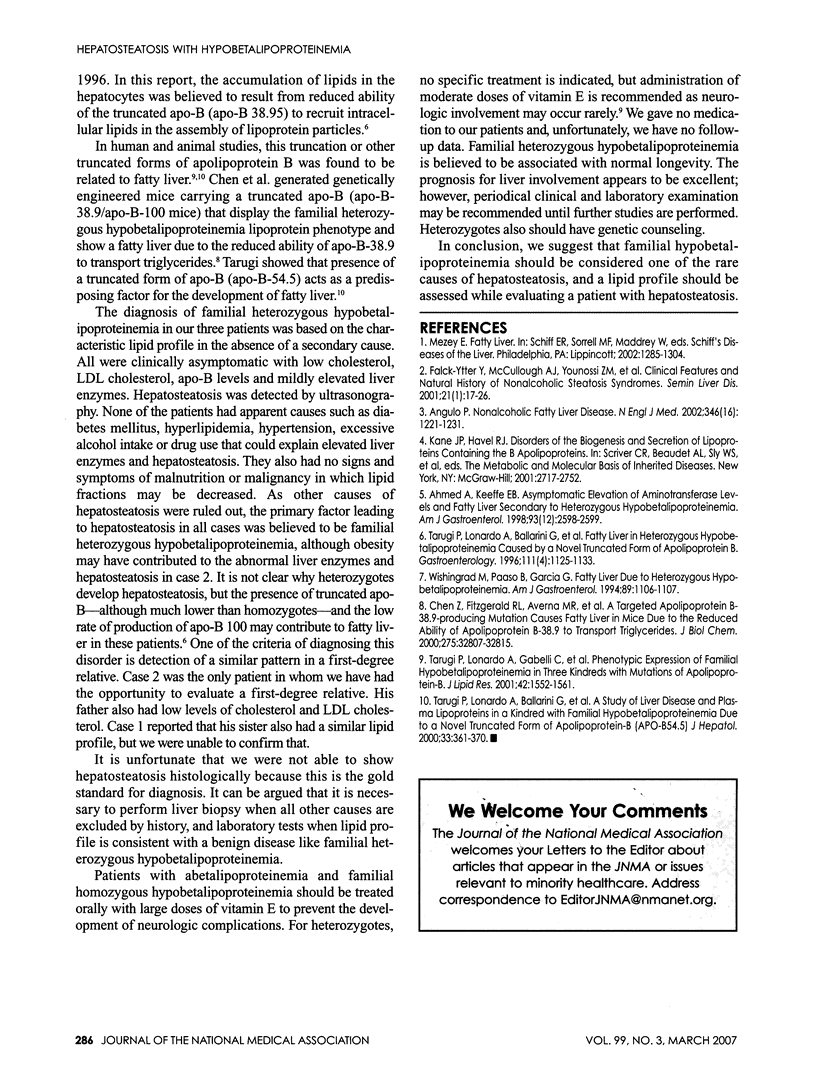Abstract
Nonalcoholic fatty liver disease is increasingly recognized as a condition that may progress to chronic liver disease. Most cases of fatty liver are asymptomatic and often are detected during routine medical or laboratory examinations. There also are some rare genetic diseases such as abetalipoproteinemia and familial hypobetalipoproteinemia that may cause fatty liver disease. Both are inherited disorders of lipoprotein metabolism. Although abetalipoproteinemia and homozygous familial hypobetalipoproteinemia patients present with severe manifestations, heterozygotes are usually asymptomatic. In the last several years, case reports or studies indicating a relationship between hepatosteatosis and familial heterozygote hypobetalipoproteinemia (FHBL) have been reported. Here, we report three cases of FHBL with characteristic lipid profile, mildly elevated liver enzymes and hepatosteatosis confirmed by ultrasonography.
Full text
PDF


Selected References
These references are in PubMed. This may not be the complete list of references from this article.
- Ahmed A., Keeffe E. B. Asymptomatic elevation of aminotransferase levels and fatty liver secondary to heterozygous hypobetalipoproteinemia. Am J Gastroenterol. 1998 Dec;93(12):2598–2599. doi: 10.1111/j.1572-0241.1998.00732.x. [DOI] [PubMed] [Google Scholar]
- Angulo Paul. Nonalcoholic fatty liver disease. N Engl J Med. 2002 Apr 18;346(16):1221–1231. doi: 10.1056/NEJMra011775. [DOI] [PubMed] [Google Scholar]
- Chen Z., Fitzgerald R. L., Averna M. R., Schonfeld G. A targeted apolipoprotein B-38.9-producing mutation causes fatty livers in mice due to the reduced ability of apolipoprotein B-38.9 to transport triglycerides. J Biol Chem. 2000 Oct 20;275(42):32807–32815. doi: 10.1074/jbc.M004913200. [DOI] [PubMed] [Google Scholar]
- Falck-Ytter Y., Younossi Z. M., Marchesini G., McCullough A. J. Clinical features and natural history of nonalcoholic steatosis syndromes. Semin Liver Dis. 2001;21(1):17–26. doi: 10.1055/s-2001-12926. [DOI] [PubMed] [Google Scholar]
- Tarugi P., Lonardo A., Ballarini G., Erspamer L., Tondelli E., Bertolini S., Calandra S. A study of fatty liver disease and plasma lipoproteins in a kindred with familial hypobetalipoproteinemia due to a novel truncated form of apolipoprotein B (APO B-54.5). J Hepatol. 2000 Sep;33(3):361–370. doi: 10.1016/s0168-8278(00)80270-6. [DOI] [PubMed] [Google Scholar]
- Tarugi P., Lonardo A., Ballarini G., Grisendi A., Pulvirenti M., Bagni A., Calandra S. Fatty liver in heterozygous hypobetalipoproteinemia caused by a novel truncated form of apolipoprotein B. Gastroenterology. 1996 Oct;111(4):1125–1133. doi: 10.1016/s0016-5085(96)70082-3. [DOI] [PubMed] [Google Scholar]
- Tarugi P., Lonardo A., Gabelli C., Sala F., Ballarini G., Cortella I., Previato L., Bertolini S., Cordera R., Calandra S. Phenotypic expression of familial hypobetalipoproteinemia in three kindreds with mutations of apolipoprotein B gene. J Lipid Res. 2001 Oct;42(10):1552–1561. [PubMed] [Google Scholar]
- Wald A. Understanding the pathophysiology of dysphagia and constipation in neurologic disorders. Am J Gastroenterol. 1994 Jan;89(1):1–3. [PubMed] [Google Scholar]


